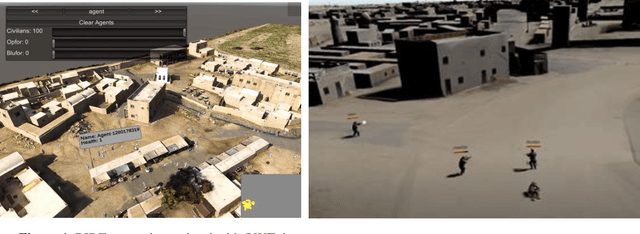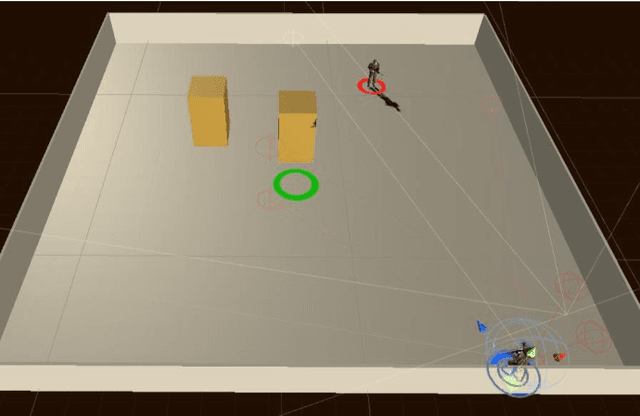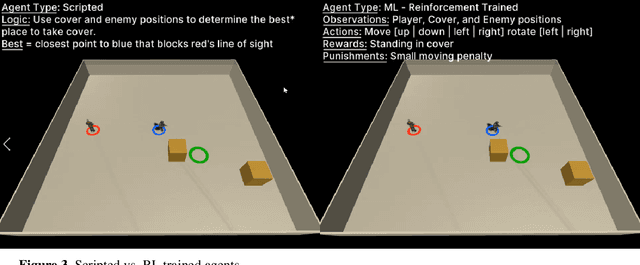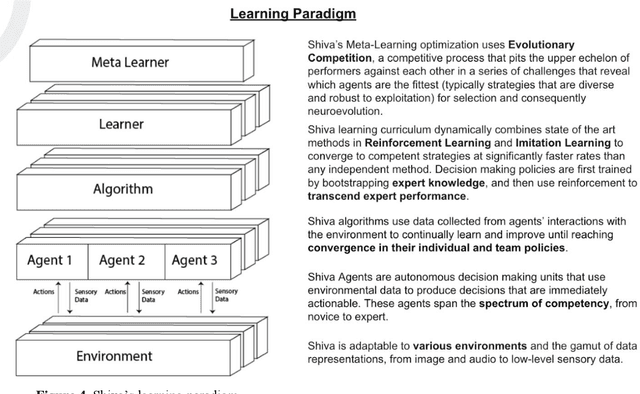Volkan Ustun
X-Ego: Acquiring Team-Level Tactical Situational Awareness via Cross-Egocentric Contrastive Video Representation Learning
Oct 22, 2025Abstract:Human team tactics emerge from each player's individual perspective and their ability to anticipate, interpret, and adapt to teammates' intentions. While advances in video understanding have improved the modeling of team interactions in sports, most existing work relies on third-person broadcast views and overlooks the synchronous, egocentric nature of multi-agent learning. We introduce X-Ego-CS, a benchmark dataset consisting of 124 hours of gameplay footage from 45 professional-level matches of the popular e-sports game Counter-Strike 2, designed to facilitate research on multi-agent decision-making in complex 3D environments. X-Ego-CS provides cross-egocentric video streams that synchronously capture all players' first-person perspectives along with state-action trajectories. Building on this resource, we propose Cross-Ego Contrastive Learning (CECL), which aligns teammates' egocentric visual streams to foster team-level tactical situational awareness from an individual's perspective. We evaluate CECL on a teammate-opponent location prediction task, demonstrating its effectiveness in enhancing an agent's ability to infer both teammate and opponent positions from a single first-person view using state-of-the-art video encoders. Together, X-Ego-CS and CECL establish a foundation for cross-egocentric multi-agent benchmarking in esports. More broadly, our work positions gameplay understanding as a testbed for multi-agent modeling and tactical learning, with implications for spatiotemporal reasoning and human-AI teaming in both virtual and real-world domains. Code and dataset are available at https://github.com/HATS-ICT/x-ego.
Abstracting Geo-specific Terrains to Scale Up Reinforcement Learning
Mar 25, 2025Abstract:Multi-agent reinforcement learning (MARL) is increasingly ubiquitous in training dynamic and adaptive synthetic characters for interactive simulations on geo-specific terrains. Frameworks such as Unity's ML-Agents help to make such reinforcement learning experiments more accessible to the simulation community. Military training simulations also benefit from advances in MARL, but they have immense computational requirements due to their complex, continuous, stochastic, partially observable, non-stationary, and doctrine-based nature. Furthermore, these simulations require geo-specific terrains, further exacerbating the computational resources problem. In our research, we leverage Unity's waypoints to automatically generate multi-layered representation abstractions of the geo-specific terrains to scale up reinforcement learning while still allowing the transfer of learned policies between different representations. Our early exploratory results on a novel MARL scenario, where each side has differing objectives, indicate that waypoint-based navigation enables faster and more efficient learning while producing trajectories similar to those taken by expert human players in CSGO gaming environments. This research points out the potential of waypoint-based navigation for reducing the computational costs of developing and training MARL models for military training simulations, where geo-specific terrains and differing objectives are crucial.
Spontaneous Theory of Mind for Artificial Intelligence
Feb 16, 2024Abstract:Existing approaches to Theory of Mind (ToM) in Artificial Intelligence (AI) overemphasize prompted, or cue-based, ToM, which may limit our collective ability to develop Artificial Social Intelligence (ASI). Drawing from research in computer science, cognitive science, and related disciplines, we contrast prompted ToM with what we call spontaneous ToM -- reasoning about others' mental states that is grounded in unintentional, possibly uncontrollable cognitive functions. We argue for a principled approach to studying and developing AI ToM and suggest that a robust, or general, ASI will respond to prompts \textit{and} spontaneously engage in social reasoning.
Controlling Synthetic Characters in Simulations: A Case for Cognitive Architectures and Sigma
Jan 06, 2021



Abstract:Simulations, along with other similar applications like virtual worlds and video games, require computational models of intelligence that generate realistic and credible behavior for the participating synthetic characters. Cognitive architectures, which are models of the fixed structure underlying intelligent behavior in both natural and artificial systems, provide a conceptually valid common basis, as evidenced by the current efforts towards a standard model of the mind, to generate human-like intelligent behavior for these synthetic characters. Sigma is a cognitive architecture and system that strives to combine what has been learned from four decades of independent work on symbolic cognitive architectures, probabilistic graphical models, and more recently neural models, under its graphical architecture hypothesis. Sigma leverages an extended form of factor graphs towards a uniform grand unification of not only traditional cognitive capabilities but also key non-cognitive aspects, creating unique opportunities for the construction of new kinds of cognitive models that possess a Theory-of-Mind and that are perceptual, autonomous, interactive, affective, and adaptive. In this paper, we will introduce Sigma along with its diverse capabilities and then use three distinct proof-of-concept Sigma models to highlight combinations of these capabilities: (1) Distributional reinforcement learning models in; (2) A pair of adaptive and interactive agent models that demonstrate rule-based, probabilistic, and social reasoning; and (3) A knowledge-free exploration model in which an agent leverages only architectural appraisal variables, namely attention and curiosity, to locate an item while building up a map in a Unity environment.
Adaptive Synthetic Characters for Military Training
Jan 06, 2021



Abstract:Behaviors of the synthetic characters in current military simulations are limited since they are generally generated by rule-based and reactive computational models with minimal intelligence. Such computational models cannot adapt to reflect the experience of the characters, resulting in brittle intelligence for even the most effective behavior models devised via costly and labor-intensive processes. Observation-based behavior model adaptation that leverages machine learning and the experience of synthetic entities in combination with appropriate prior knowledge can address the issues in the existing computational behavior models to create a better training experience in military training simulations. In this paper, we introduce a framework that aims to create autonomous synthetic characters that can perform coherent sequences of believable behavior while being aware of human trainees and their needs within a training simulation. This framework brings together three mutually complementary components. The first component is a Unity-based simulation environment - Rapid Integration and Development Environment (RIDE) - supporting One World Terrain (OWT) models and capable of running and supporting machine learning experiments. The second is Shiva, a novel multi-agent reinforcement and imitation learning framework that can interface with a variety of simulation environments, and that can additionally utilize a variety of learning algorithms. The final component is the Sigma Cognitive Architecture that will augment the behavior models with symbolic and probabilistic reasoning capabilities. We have successfully created proof-of-concept behavior models leveraging this framework on realistic terrain as an essential step towards bringing machine learning into military simulations.
Outperforming Word2Vec on Analogy Tasks with Random Projections
Feb 17, 2015Abstract:We present a distributed vector representation based on a simplification of the BEAGLE system, designed in the context of the Sigma cognitive architecture. Our method does not require gradient-based training of neural networks, matrix decompositions as with LSA, or convolutions as with BEAGLE. All that is involved is a sum of random vectors and their pointwise products. Despite the simplicity of this technique, it gives state-of-the-art results on analogy problems, in most cases better than Word2Vec. To explain this success, we interpret it as a dimension reduction via random projection.
 Add to Chrome
Add to Chrome Add to Firefox
Add to Firefox Add to Edge
Add to Edge